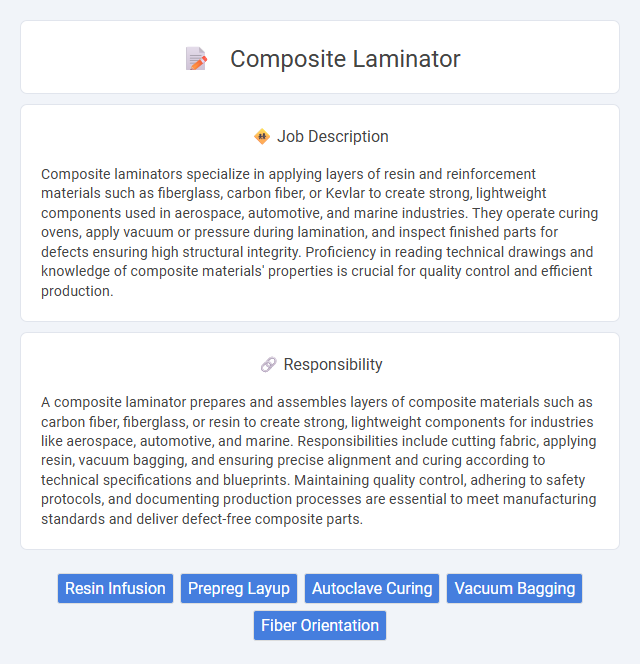
Composite laminators specialize in applying layers of resin and reinforcement materials such as fiberglass, carbon fiber, or Kevlar to create strong, lightweight components used in aerospace, automotive, and marine industries. They operate curing ovens, apply vacuum or pressure during lamination, and inspect finished parts for defects ensuring high structural integrity. Proficiency in reading technical drawings and knowledge of composite materials' properties is crucial for quality control and efficient production.
People with good manual dexterity and strong attention to detail are likely to be well-suited for a composite laminator job, as it involves precise layering and curing of materials. Candidates who are comfortable working in controlled environments and can handle repetitive tasks with patience may find this role manageable. However, those with physical limitations affecting fine motor skills or who struggle with maintaining focus over extended periods might face challenges in this position.
Qualification
A composite laminator typically requires a high school diploma or equivalent, along with specialized training in composite materials and lamination techniques. Proficiency in reading blueprints, attention to detail, and experience with automated or manual layup processes significantly enhance job performance. Certification in composite fabrication or related manufacturing processes is often preferred by employers for this role.
Responsibility
A composite laminator prepares and assembles layers of composite materials such as carbon fiber, fiberglass, or resin to create strong, lightweight components for industries like aerospace, automotive, and marine. Responsibilities include cutting fabric, applying resin, vacuum bagging, and ensuring precise alignment and curing according to technical specifications and blueprints. Maintaining quality control, adhering to safety protocols, and documenting production processes are essential to meet manufacturing standards and deliver defect-free composite parts.
Benefit
A composite laminator job offers the probability of gaining specialized skills in handling advanced materials, which may enhance career prospects in aerospace, automotive, and marine industries. This role likely provides hands-on experience with cutting-edge manufacturing technologies, potentially increasing employability and salary potential. Working as a composite laminator could also improve problem-solving abilities and attention to detail, valuable traits for future technical or supervisory positions.
Challenge
Working as a composite laminator likely involves complex challenges related to precision and consistency in layering materials to ensure structural integrity. The role may require careful handling of various resins and fibers under strict quality control standards, increasing the probability of encountering detailed manual work and technical troubleshooting. Managing these challenges could demand thorough knowledge of composite materials and adaptability to shifting production demands.
Career Advancement
A composite laminator career offers significant advancement opportunities through skill development in advanced materials and manufacturing techniques. Proficiency in operating automated laminating machinery and understanding composite material properties can lead to supervisory or quality control roles. Continuous training and certifications in aerospace or automotive composites further enhance promotion potential within the industry.
Key Terms
Resin Infusion
A composite laminator specializing in resin infusion expertly layers high-performance fibers and carefully controls resin distribution to create strong, lightweight composite structures. Precision in vacuum bagging and resin flow management ensures optimal fiber wet-out and minimal void content, enhancing the mechanical properties of aerospace, automotive, and marine components. Advanced knowledge of resin chemistry and curing cycles is essential for producing defect-free laminates with superior durability and performance.
Prepreg Layup
Prepreg layup in composite laminator jobs involves precisely stacking pre-impregnated composite fibers to ensure optimal fiber alignment and resin distribution for superior mechanical performance. Accurate placement and consolidation during layup are critical to achieving desired thickness, weight, and structural integrity in aerospace, automotive, and marine applications. Mastery of temperature control and vacuum bagging techniques enhances bonding quality and reduces void content in the final composite laminate.
Autoclave Curing
Composite laminators specializing in autoclave curing ensure precise pressure and temperature control to achieve optimal resin polymerization in advanced composite materials. This process enhances the mechanical properties, surface finish, and structural integrity of aerospace and automotive components. Expertise in autoclave operation and safety protocols is crucial for maintaining quality standards and minimizing material defects.
Vacuum Bagging
A composite laminator specializing in vacuum bagging meticulously layers resin-impregnated fabrics within a sealed bag to eliminate air pockets and ensure even pressure during curing. Mastery of vacuum pump operation and bagging techniques enhances the structural integrity and surface finish of aerospace and marine composite components. Precision in vacuum monitoring and temperature control is critical to achieving optimal laminate strength and minimizing defects.
Fiber Orientation
Composite laminators precisely arrange fiber orientation to maximize strength, stiffness, and durability in advanced materials such as carbon fiber and fiberglass products. Correct alignment of fibers at specific angles optimizes load distribution and enhances resistance to stress and fatigue in aerospace, automotive, and marine applications. Mastery of fiber orientation techniques ensures the structural integrity and performance consistency of composite laminates.
 kuljobs.com
kuljobs.com